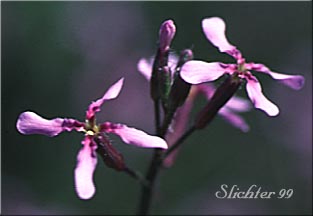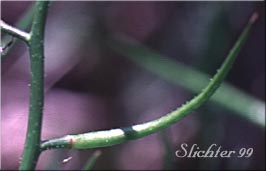

 The photo
at right shows a maturing fruit of blue mustard from U.S. 97 in the Yakima Indian Reservation..........May 10, 1997.
The photo
at right shows a maturing fruit of blue mustard from U.S. 97 in the Yakima Indian Reservation..........May 10, 1997.
Blue mustard is a leafy, spreading, annual, branched from the base, and rising from 10-50 cm in height. The leaves are oblanceolate, with sinuous or coarsely-toothed leaf edges. The lower leaves are petiolate, the uppermost are sessile, with the blades from 3-8 cm long.
The racemes are elongated, with the lower flowers from the axils of the upper leaves. The pale purple flowers each have 4 narrow petals about 5 mm long. The siliques are about 3.5-4.5 cm long, arched, and spreading or ascending (See photo below).
Blue mustard is found in cultivated areas where it reduces crop yields, and in open, disturbed places.
Although it is a native of Russia and southwestern Asia, it is now established in the drier inland parts of the Pacific Northwest.
In the Columbia River Gorge it may be found east of Lyle, WA between the elevations of 100'-800'.
Blue mustard has a disagreeable odor, which may be transferred to the milk of dairy animals which eat the plant.